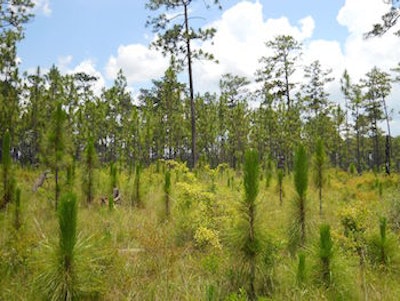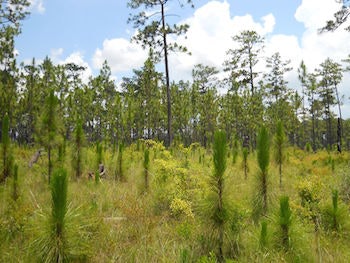
 Naturally regenerated longleaf pines in DeSoto National Forest, Miss. (Photo from Wikipedia/Woodlot)
Naturally regenerated longleaf pines in DeSoto National Forest, Miss. (Photo from Wikipedia/Woodlot)
No, I’m not talking about the Amazon. Nor forests in Africa or somewhere in Indonesia. The loss happened right here at home, in the good old United States of America.
The longleaf pine forest once covered 90 million acres, or about 60 percent of the land, in a virtually continuous 1,200-mile stretch across nine states from Virginia to East Texas. That forest has been reduced by 97 percent, and there are about three million acres of it left. That’s more catastrophic than what has happened to coral reefs (10 percent to 20 percent destroyed) or the Amazon rainforest (more than 20 percent). The longleaf pine forest’s “Big Cut,” as it’s still known, began after the Civil War and left behind what commentators referred to as “a sea of stumps.” Much of the land has since been reforested, but de-longleafed, and is now planted with row after row of faster-growing pines raised for pulpwood.
That is pulled out of my current must-read to all of you in the U.S. forest industry, this Smithsonian article on the Half Earth program.
The Half Earth program has the ambitious goal of setting aside half the planet for wild nature and half for humans. Don’t just roll your eyes now—they have some solid ideas on how it might be accomplished. And what’s very interesting to me is how they look at the pluses and minuses in our current national park system and conservation methods.
Our national parks cover 4 percent of the nation. That’s either “just” 4 percent or a “whopping” 4 percent depending on your point of view. No matter if it is “just” or “whopping,” it’s a wonderful thing and, hey, it’s an American creation. We invented the concept of a “national park” in 1871 with the creation of Yellowstone. And the world followed suit—there are now over 5,000 national parks among the planet’s 200,000 protected areas.
But the system is also flawed because it creates these parks in self-contained chunks.
But the system is also flawed because it creates these parks in self-contained chunks, and birds and animals and plants just don’t see borders. They like to roam around and many of them have established patterns of ranging north and south or east and west. Often we have a park here and a park there with a development of some sort between them. One idea is to create corridors to allow animals to move freely, to range naturally, between the larger chunks of protected wilderness.
The article covers trial programs that are seeing some tremendous success. It also looks at the possibility of seeing the New England region become roughly 70 percent permanently forested. That area was “90 percent forested when the Pilgrims arrived, but almost 200 years later farmers chopped down all but 20 percent of the trees…”. Now:
…the forests returned, though no one in the 21st century will see anything like those first forests’ practically sequoia-size Eastern white pines, trees that awed early settlers. Timbering is common in the newer woods, and even if left strictly alone, white pines need 400 years to tower over everything in sight. The “reforests,” if you can call them that, instill their own wonder, though. Self-seeded, they’ve spread again to cover 79 percent of New England, and a recent report refers to the entire six-state region as a “continental-scale habitat corridor.” … something rare in the biosphere: a “second-chance landscape.”
We’ve been discussing the Northern Long Eared Bat specifically and the Endangered Species Act generally—now, let’s look at the entire natural condition of the U.S. Do we have a second chance here? Can we bring back these forests (and the animals, birds and plants that live in them) and find a way to better share the resources? Do read the article and for more information beyond that, see also:
http://www.wildlandsandwoodlands.org/news/wilson%E2%80%99s-half-earth-vision
and
http://eowilsonfoundation.org/tag/e-o-wilson/
































